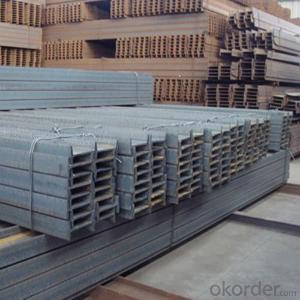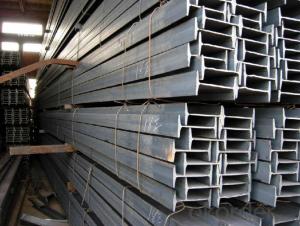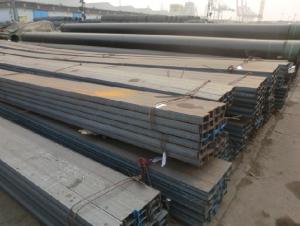80*46mm IPEAA200 ASTM A36 for construction
- Loading Port:
- Tianjin
- Payment Terms:
- TT or LC
- Min Order Qty:
- 25 m.t.
- Supply Capability:
- 100000 m.t./month
OKorder Service Pledge
OKorder Financial Service
You Might Also Like
1. Structure of Steel I Beam IPE Description:
Steel I beam IPE is a beam with an I-shaped cross-section. The horizontal elements of the "I" are known as flanges, while the vertical element is termed the "web". Steel I beam IPE is usually made of structural steel and is used in construction and civil engineering. The Steel I beam IPE resists shear forces, while the flanges resist most of the bending moment experienced by the beam. Steel I beam IPE theory shows that the I-shaped section is a very efficient form for carrying both bending and shears loads in the plane of the web.
2. Main Features of Steel I Beam IPE:
• Grade: Q235
• Type: Mild carbon steel
• Deflection: The stiffness of the I-beam will be chosen to minimize deformation
• Vibration: The stiffness and mass are chosen to prevent unacceptable vibrations, particularly in settings sensitive to vibrations, such as offices and libraries.
• Local yield: Caused by concentrated loads, such as at the beam's point of support.
1. Structure of Steel I Beam IPE Description:
Steel I beam IPE is a beam with an I-shaped cross-section. The horizontal elements of the "I" are known as flanges, while the vertical element is termed the "web". Steel I beam IPE is usually made of structural steel and is used in construction and civil engineering. The Steel I beam IPE resists shear forces, while the flanges resist most of the bending moment experienced by the beam. Steel I beam IPE theory shows that the I-shaped section is a very efficient form for carrying both bending and shears loads in the plane of the web.
2. Main Features of Steel I Beam IPE:
• Grade: Q235
• Type: Mild carbon steel
• Deflection: The stiffness of the I-beam will be chosen to minimize deformation
• Vibration: The stiffness and mass are chosen to prevent unacceptable vibrations, particularly in settings sensitive to vibrations, such as offices and libraries.
• Local yield: Caused by concentrated loads, such as at the beam's point of support.
Package & Delivery of IPE Beam
1. Packing: it is nude packed in bundles by steel wire rod
2. Bundle weight: not more than 3.5MT for bulk vessel; less than 3 MT for container load
3. Marks: Color marking: There will be color marking on both end of the bundle for the cargo delivered by bulk vessel. That makes it easily to distinguish at the destination port.
4. Tag mark: there will be tag mark tied up on the bundles. The information usually including supplier logo and name, product name, made in China, shipping marks and other information request by the customer.
If loading by container the marking is not needed, but we will prepare it as customer request.
5. Transportation: the goods are delivered by truck from mill to loading port, the maximum quantity can be loaded is around 40MTs by each truck. If the order quantity cannot reach the full truck loaded, the transportation cost per ton will be little higher than full load.
6. Delivery of IPE Beam: 30 days after getting L/C Original at sight or T/T in advance
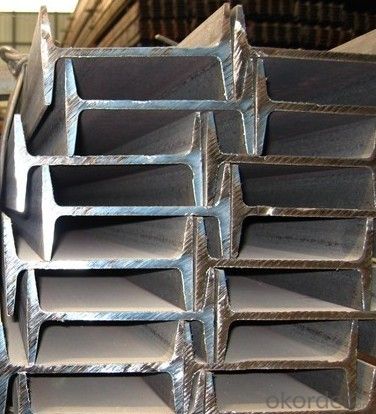
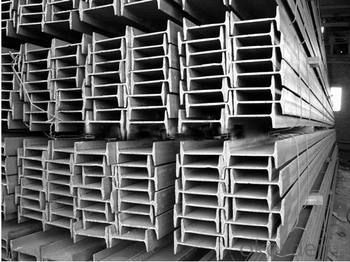

- Q:How do steel I-beams handle dynamic loads from moving vehicles?
- Steel I-beams are designed to handle dynamic loads from moving vehicles in a highly effective manner. These beams have excellent strength and load-bearing capabilities, making them ideal for supporting heavy loads and withstanding the dynamic forces generated by moving vehicles. One of the key features that allows steel I-beams to handle dynamic loads is their high structural stiffness. The I-shaped cross-section of these beams provides them with a superior resistance to bending and torsional forces, ensuring that they can effectively handle the dynamic loads imposed by moving vehicles. This structural stiffness helps distribute the load evenly across the length of the beam, preventing localized stress concentrations and minimizing the risk of failure. Moreover, steel I-beams are typically manufactured from high-quality, high-strength steel, which further enhances their ability to handle dynamic loads. This type of steel possesses excellent mechanical properties, such as high tensile strength and toughness, that enable the beam to resist deformation and maintain its structural integrity under the dynamic forces exerted by moving vehicles. In addition to their inherent structural strength, steel I-beams can also be reinforced or supplemented with additional components to further enhance their ability to handle dynamic loads. For instance, steel plates or brackets can be welded or bolted to the beam's flanges or web to increase its load-carrying capacity and provide extra support. Overall, steel I-beams are specifically designed and engineered to handle dynamic loads from moving vehicles effectively. Their structural stiffness, high-strength steel construction, and potential for reinforcement make them a reliable and durable choice for supporting heavy loads and withstanding the dynamic forces generated by vehicles in motion.
- Q:How do steel I-beams perform in extreme weather conditions?
- Steel I-beams are known for their exceptional strength and durability, making them highly suitable for withstanding extreme weather conditions. Whether it is extreme heat, freezing temperatures, heavy rainfall, or strong winds, steel I-beams can perform exceptionally well. One of the key advantages of steel I-beams is their resistance to temperature fluctuations. Unlike other materials, steel does not expand or contract significantly due to temperature changes. This makes steel I-beams particularly reliable in extreme heat or cold, ensuring that they maintain their structural integrity over time. In severe weather conditions such as hurricanes or strong winds, steel I-beams are highly resistant to bending or breaking. The I-shape design of the beams provides excellent load-bearing capabilities, allowing them to withstand heavy winds and prevent structural failures. This is particularly important in areas prone to tornadoes, hurricanes, or other high-wind events. Steel I-beams also perform well in heavy rainfall or snowfall. Their inherent strength allows them to bear the weight of accumulated snow or the force of heavy rain without buckling or collapsing. Additionally, steel is resistant to water damage, corrosion, and rotting, ensuring the longevity and structural stability of the I-beams in wet conditions. Moreover, steel I-beams have a high fire resistance compared to other materials. In the event of a fire, steel does not combust, melt, or contribute to the spread of flames. This characteristic makes steel I-beams a reliable choice in areas prone to wildfires or other fire hazards. Overall, steel I-beams are designed to withstand extreme weather conditions and perform exceptionally well in such situations. Their strength, durability, resistance to temperature fluctuations, wind resistance, and fire resistance make them a reliable choice for various construction projects, ensuring the safety and stability of structures even in the harshest weather conditions.
- Q:What are the design considerations for using steel I-beams?
- When incorporating steel I-beams into structural design, it is important to keep in mind several key considerations. Firstly, the load-bearing capacity of the I-beams must be taken into account. This involves ensuring that the beams can adequately support the anticipated loads, including both dead loads and live loads. It is necessary to select I-beams of appropriate size, shape, and material properties to achieve the necessary strength without excessive deflection or failure. Secondly, the span length and spacing between the I-beams are critical factors to consider. Longer spans require larger and stronger beams to prevent excessive deflection. The spacing between the beams should be determined based on the anticipated loads and the required stiffness of the structure. Properly spacing the I-beams is essential for even load distribution and to ensure the structural integrity of the building or bridge. Thirdly, the connection details between the steel I-beams and other structural elements are crucial for overall stability and strength. Different methods, such as welding, bolting, or a combination of both, can be used to connect the beams to columns, foundations, or other supporting elements. The connection design should consider factors such as load transfer, shear and moment resistance, and compatibility with the surrounding materials. Fourthly, fire resistance is an important consideration when using steel I-beams in buildings. Although steel is a non-combustible material, it can lose its strength when exposed to high temperatures. Therefore, measures should be taken to enhance the fire resistance of the steel beams, such as fire-rated insulation, intumescent coatings, or encasement with fire-resistant materials. These measures ensure the structural integrity of the steel beams in the event of a fire. Lastly, the cost and availability of steel I-beams should be taken into consideration. Factors such as the size, grade, and fabrication requirements of the beams can impact their cost. Additionally, availability can be influenced by local steel suppliers, manufacturing lead times, and transportation logistics. It is important to strike a balance between the desired design, cost-efficiency, and accessibility when selecting steel I-beams. In conclusion, the design considerations for incorporating steel I-beams into structural design include assessing load-bearing capacity, span length and spacing, connection details, fire resistance, and cost and availability. Careful evaluation of these factors is crucial to ensure a safe and structurally sound design using steel I-beams.
- Q:What are the different types of steel I-beams?
- There are several different types of steel I-beams, each designed to meet specific structural needs and requirements. Some of the most common types include: 1. W-Beam: This is the most commonly used type of I-beam and features a wide flange section that resembles the letter "W". It provides excellent support and load-bearing capabilities, making it suitable for a wide range of applications. 2. S-Beam: Also known as American Standard Beams, S-beams have a narrower flange section that resembles the letter "S". They are commonly used in residential construction and light to medium-duty applications. 3. HP-Beam: HP-beams, also known as H-piles, feature a wider flange section and are primarily used for deep foundation applications, such as supporting large structures or bridges. They provide excellent load-bearing capacity and resistance to lateral forces. 4. M-Beam: M-beams, or miscellaneous beams, are typically used for smaller-scale applications or where specific load requirements need to be met. They come in various sizes and are commonly used in the construction industry for framing, support structures, and other similar applications. 5. L-Beam: L-beams, or angle beams, have two legs that form an L-shape. They are primarily used for structural purposes, such as providing support for columns, beams, or as braces in construction projects. 6. C-Beam: C-beams, or channel beams, have a C-shaped cross-section and are commonly used for structural purposes, such as framing, support, or as tracks for sliding doors or windows. These are just a few examples of the different types of steel I-beams available. It is essential to choose the right type based on the specific requirements of the project, including load-bearing capacity, span, and structural needs. Consulting with a structural engineer or steel supplier can help determine the most suitable type of I-beam for a particular application.
- Q:What are the maximum lengths available for Steel I-Beams?
- The maximum lengths for Steel I-Beams vary due to several factors, such as the manufacturer, the specific type and size of the I-Beam, and transportation and handling limitations. Typically, Steel I-Beams are found in standard lengths ranging from 20 to 60 feet. However, it should be noted that longer lengths could be obtained through special request or customization. Some manufacturers even offer lengths exceeding 100 feet. It is important to consider that longer lengths may present certain limitations. The transportation and handling of extremely long I-Beams can be challenging and may necessitate specialized equipment and experienced personnel. In addition, it is crucial to consult with the manufacturer or supplier to determine the maximum length available for the specific type and size of I-Beam you require. They will be able to provide accurate information based on their product range and capabilities.
- Q:What are the load-bearing capacity of rectangular and I-beam steel sections of the same size?
- In the same section size, the web and wing plate of I-beam are higher than rectangular steel, so the modulus of bending section is also high.
- Q:Can steel I-beams be used in both residential and commercial buildings?
- Yes, steel I-beams can be used in both residential and commercial buildings. Steel I-beams are commonly used as structural supports due to their strength, durability, and versatility. They provide excellent load-bearing capabilities, allowing for the construction of large spans and open floor plans. In residential buildings, steel I-beams are often used to support the weight of upper floors and roof structures. In commercial buildings, they are frequently employed in the construction of warehouses, factories, and high-rise buildings. The use of steel I-beams ensures the structural integrity of the building, making them suitable for various applications in both residential and commercial settings.
- Q:What are the different types of connections used for steel I-beams?
- Steel I-beams can be connected using different types of connections, which vary depending on the specific application and structural requirements. Some common connection types include: 1. The most commonly used connection for steel I-beams is welding. This involves welding the I-beam to a connection plate or another beam to create a strong and durable joint. 2. Another widely used method is bolted connections. These connections involve using bolts and nuts to fasten the beams together. Bolted connections offer the advantage of easy adjustment or dismantling if necessary, making them a flexible option. 3. Riveted connections, although less common nowadays, were historically used. This method involves using metal pins with a formed head on one end, called rivets, to connect the I-beams. Riveted connections provide high strength and durability. 4. Pinned connections allow for rotational movement between the connected beams. This type of connection is often used in structures that require flexibility, such as bridges or seismic-resistant buildings. Pinned connections typically use pins or bearings to enable rotation. 5. Moment connections are designed to transfer both vertical and horizontal loads between beams. These connections are used in structures that require a rigid connection to resist bending moments. Moment connections can be achieved through welding or bolting and provide high strength and stability. It is important to consider factors such as load requirements, structural design, and construction methods when choosing a connection type. Consulting with a structural engineer or qualified professional is crucial to ensure the appropriate connection type is chosen for specific applications.
- Q:Can Steel I-Beams be used for agricultural buildings?
- Certainly, agricultural buildings can indeed utilize steel I-beams. Renowned for their robustness and longevity, steel I-beams prove to be an ideal choice for supporting extensive agricultural structures. They are frequently employed in the construction of barns, stables, storage facilities, and other agricultural edifices. With their exceptional load-bearing capacities, steel I-beams can effortlessly withstand the demands of heavy equipment, machinery, and storage necessities commonly found in agricultural operations. Moreover, steel's resistance to pests, fire, and decay renders it a dependable option for agricultural buildings that must endure harsh environmental conditions. Furthermore, the versatility and ease of assembly of steel I-beams enable flexible designs that can adapt to diverse agricultural requirements.
- Q:How are steel I-beams protected against galvanic corrosion?
- Steel I-beams are protected against galvanic corrosion by applying a protective coating, such as paint or galvanizing. This creates a barrier between the steel and other metals, preventing the formation of an electrolytic cell that leads to galvanic corrosion.
1. Manufacturer Overview |
|
|---|---|
| Location | |
| Year Established | |
| Annual Output Value | |
| Main Markets | |
| Company Certifications | |
2. Manufacturer Certificates |
|
|---|---|
| a) Certification Name | |
| Range | |
| Reference | |
| Validity Period | |
3. Manufacturer Capability |
|
|---|---|
| a)Trade Capacity | |
| Nearest Port | |
| Export Percentage | |
| No.of Employees in Trade Department | |
| Language Spoken: | |
| b)Factory Information | |
| Factory Size: | |
| No. of Production Lines | |
| Contract Manufacturing | |
| Product Price Range | |
Send your message to us
80*46mm IPEAA200 ASTM A36 for construction
- Loading Port:
- Tianjin
- Payment Terms:
- TT or LC
- Min Order Qty:
- 25 m.t.
- Supply Capability:
- 100000 m.t./month
OKorder Service Pledge
OKorder Financial Service
Similar products
New products
Hot products
Hot Searches
Related keywords
